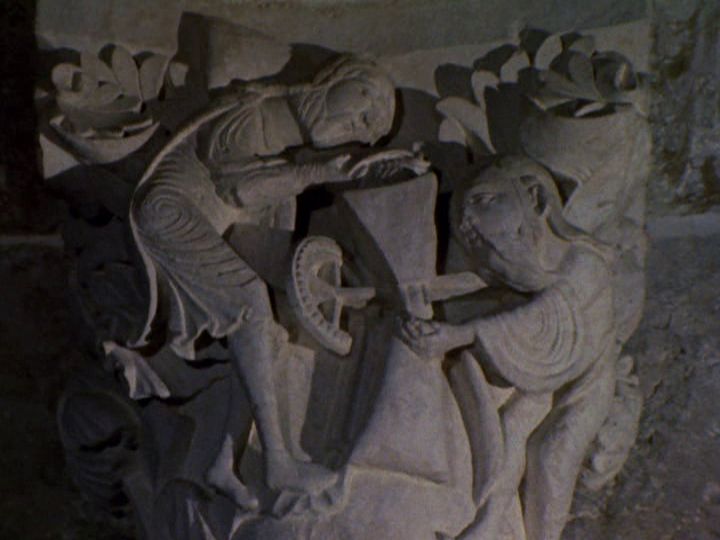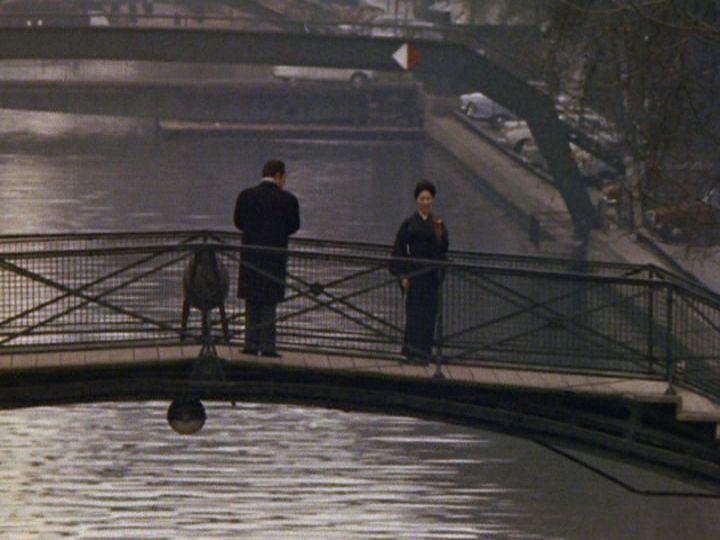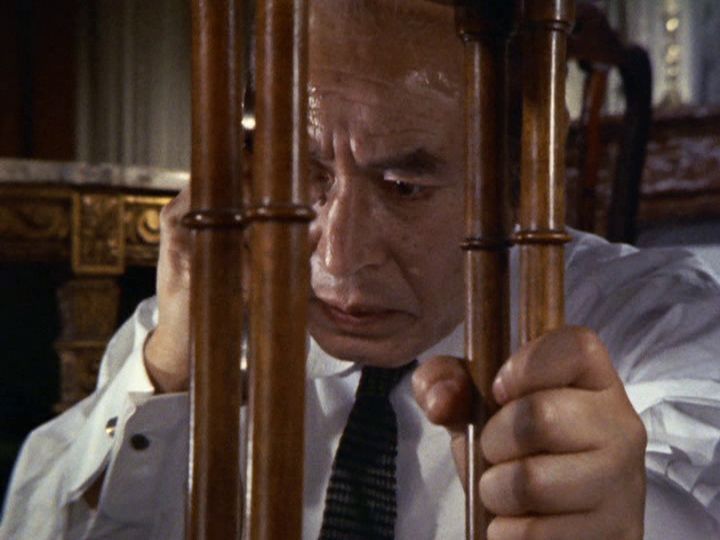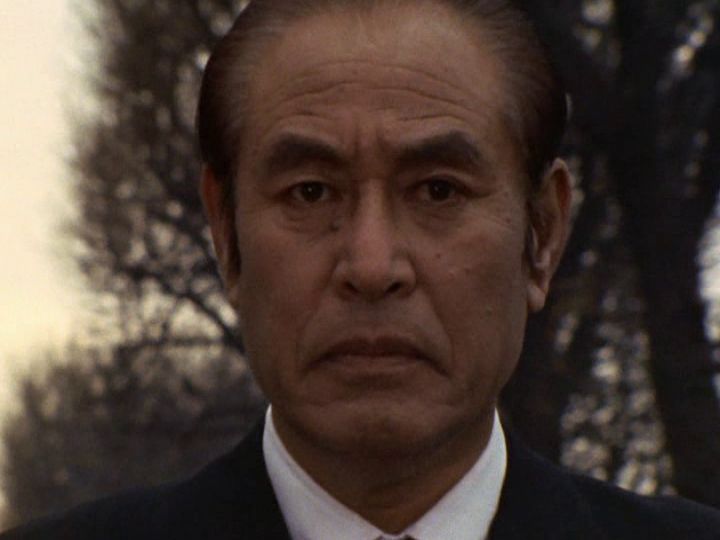The Fossil (Kaseki, 1975), based on a novel by Yasushi Inoue, is about the elderly businessman Itsuki (Shin Saburi), who is diagnosed with cancer while on a trip to Europe. The film was initially a television miniseries consisting of eight one-hour episodes because for Kobayashi and for many other directors, including Akira Kurosawa, the decline of the Japanese film studios in the 1970s made it more and more difficult to direct films – especially costly widescreen productions. Dissatisfied with his work for the small screen, Kobayashi turned the material shot for television into a film of 200 minutes in length for theatrical release.
Itsuki, who has built up a successful construction company with more than a thousand employees, combines a business trip to Europe with a vacation. He spends most of the time in France – in Paris and in Burgundy, and a brief trip to Granada and Cordoba is also shown. Shots of motorways and streets emphasize the aspect of travel and serve to indicate the changes in location. There are also a few beautiful landscape shots and bird’s-eye views of the roofs of Paris, and one series of shots shows the interior of the elegant but old-fashioned hotel where Itsuki stays in the French capital. Medium shots and close-ups of sculptures and architectural details are abundant, and Kobayashi’s camera lingers on the artworks – those of the sculptor Auguste Rodin on display in the Rodin Museum in Paris and also those on the column capitals in the Basilica of Saint Mary Magdalene in Vézelay and in the Cathedral of Saint Lazarus in Autun. The camera captures the finest details of the sculptures, revealing intricacies that Itsuki apparently sees.

The closed framing creates an intimacy with the protagonist, who is enchanted by these works of art, and the proliferation of medium shots and close-ups of objects and human faces is a reminder that the material was initially shot for television. However, it is also appropriate for an inner journey, which is what the plot evolves into.
Itsuki is a successful and respected man but seems not to be content with his way of life. A widower, he has become estranged from his two grown-up daughters. In the film’s first sequence, at Haneda Airport in Tokyo, the distanced relationship between him and one of his daughters is made tangible by the glass partition that separates them during their farewell scene. In Paris, Itsuki is unable to share the enthusiasm of Funazu (Hisashi Igawa), the company employee who accompanies him on his trip. This younger man, who has never been to Europe before, delights in seeing the city from the height of towers and buildings, and at one point, Itsuki joins him at the top of the Arc de Triomphe, where they admire the cityscape. However, Itsuki’s general attitude remains one of detachment, captured in Saburi’s fine acting through restrained facial expressions and body language. His whole attitude reveals the state of crisis in which Itsuki seems to be caught, and this is confirmed by the voice of a narrator explaining the protagonist’s inner torment.
Itsuki’s existential crisis comes to a head when he suddenly feels a strong pain in his abdomen and collapses. He is X-rayed, and the doctor’s diagnosis is cancer and an inoperable tumour, a diagnosis that Itsuki finds out accidentally. Keeping this health condition a secret, Itsuki first locks himself up in his hotel room, but after a while, he starts taking lonely walks in Paris and then accepts an offer to visit Burgundy and its Romanesque churches.
Death is his companion on this brief trip, during which he tries to come to terms with the new, frightening situation. The word “companion” is to be taken literally, for death is represented in the guise of a female figure. In an earlier dialogue with Funazu, Itsuki once mentioned how much he liked to see women in the black kimono of mourning, and this is how death appears: a woman looking like Madame Marcelin (Keiko Kishi), a Japanese woman married to a wealthy French entrepreneur, and Itsuki has already met the couple several times in Paris. Together with a married couple who are friends of hers, she joins Itsuki for the trip to Burgundy.

Unlike the real Madame Marcelin, who is an extravagant and colourful figure, this incarnation of death is quieter and more introverted, and in his imaginary dialogues with this materialized ghost, Itsuki’s inner voice expresses his thoughts about life and death. He reflects on the transitoriness of life, referring to both Buddhist and Christian concepts. Kobayashi’s contemplative approach to these topics via art and religion is well supported by Toru Takemitsu’s music score, inspired in one sequence by Gregorian chant. The wintry landscape filmed under a leaden-sky in both Paris and Burgundy heightens the idea of fragility symbolized by Itsuki’s aging body wasting away with cancer. In a telephone conversation with a doctor, Itsuki is sitting on the floor and is framed in close-up behind the legs of a table as if behind bars. The way he is filmed in this scene mirrors the despair he feels when he is told that he does not have long to live. Shocked by this news, Itsuki tears open the window of his hotel room with one sudden movement. In the park outside the hotel, children are playing football. Life is continuing while the sunset in the next shot suggests the twilight of human life. In another shot from the same sequence, Itsuki is framed in profile, his shadow appearing as a huge projection on the wall behind him as a symbol of weakened identity.

Kobayashi’s fragmentation of human bodies and objects by framing, camera position and editing subtly underlines this emphasis on vulnerability, with the human body a recurrent motif that Kobayashi shows or makes reference to. When Itsuki is filmed during the X-ray examination, his body is covered with a blanket and not shown, with a series of shots insisting on the X-ray machine and contrasting the coldness of the metal with the warmth of human flesh. However, the film also shows healthy bodies that exude energy and joy, for example that of the flamenco dancer with the closed framing of her sensual movements.
The material aspect of the human body has its parallel in the arts – in Rodin’s sculptures and also in the carvings in the churches in Burgundy. Kobayashi, a former student of philosophy and art, makes subtle use of Rodin’s non finito figures, the smoothness of the bronze reminiscent of the softness of human skin and the incomplete parts being not only topoi of modernity but also evoking the imperfection of human beings. Spirituality and religion meet everyday reality, with the representation of the Virgin Mary in Vézelay recalling the faces of peasant women and with sacred art inspired by medieval village life. In contrast, Itsuki experiences his journey in the French province more like a dream than an encounter with reality.
A representation of Eve makes him wonder whether, obsessed with his work, he has never lived properly, and he regrets not having devoted more attention to his wife when she was alive. He returns to Japan to find his enterprise facing serious problems that require considerable effort on his part. However, he also confronts the past, paying a visit to his home town to see his younger brother and his stepmother, a woman he hated when he was an adolescent. He regrets his former bad behaviour towards her, but the old woman now suffers from dementia and has forgotten about the past, remembering him as a particularly nice young man.
Memory is a topic that figures not only in the last part of the film but also during the stay in Burgundy, where Itsuki visits the memorial in Cerdon to the French Resistance fighters of World War II. Next to the figure of Marianne, the personification of the French Republic who thus symbolizes liberty, equality and fraternity, there is a line from the poem “Song of the Sniper” [“Chanson du franc-tireur”] by Louis Aragon carved in the stone: “Where I die, my country is reborn.” Itsuki comments on the inscription, saying that the young resistance fighters died simply trying to defend their country but that he and other Japanese soldiers took war and destruction to other countries. These thoughts recall Kobayashi’s strong pacifism and create a link between The Fossil and the rest of his cinematic oeuvre, in which he tirelessly denounces the Japanese militarism of the early 1940s.
Itsuki is a survivor of the war, a fact that for him is a burden. In Tokyo, he meets up with Yabuki (Jukichi Uno), a former army comrade, and the two men contemplate a wall of fossilized corals that could be a hundred million years old. Yabuki thinks that they could both have ended up as fossils but, having survived the war, they have been given “a bonus life”.
Itsuki is then offered another bonus. He collapses in the snow, where he has a vision of cherry trees in full bloom, symbols of transitoriness but also of renewal. H is offered a second chance when he is examined by a doctor who does not share the opinion of his colleague in France and tells him that the tumour can be removed. The operation seems to be successful and Itsuki begins to look at life differently. For the first time, he is aware of the sincerity of the many people – family members and employees – who visit him in hospital. In the film’s final sequence, the voice of the narrator is replaced by Itsuki’s, who expresses his wish to find out how to live properly. By allowing Itsuki himself to speak, Kobayashi points to the freedom his protagonist now enjoys after the operation and his experience of a life-threatening disease.
Despite its references to World War II and to the Japanese business world, The Fossil, is an introspective work, emphasizing the spiritual quest of its protagonist. Itsuki’s confrontation with death does not lead to salvation nor does it transform him into a hero struggling for a better world. Instead, it reveals the complexity of life and the inner conflicts a human being has to face when confronted with mortality, a confrontation that could lead to a life lived properly and with a greater degree of awareness.
